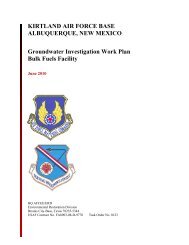Final FONSI and EA for hot cargo pad on Kirtland AFB - Kirtland Air ...
Final FONSI and EA for hot cargo pad on Kirtland AFB - Kirtland Air ...
Final FONSI and EA for hot cargo pad on Kirtland AFB - Kirtland Air ...
You also want an ePaper? Increase the reach of your titles
YUMPU automatically turns print PDFs into web optimized ePapers that Google loves.
<str<strong>on</strong>g>Final</str<strong>on</strong>g> <str<strong>on</strong>g>EA</str<strong>on</strong>g> Addressing C<strong>on</strong>structi<strong>on</strong>, Operati<strong>on</strong>, <str<strong>on</strong>g>and</str<strong>on</strong>g> Maintenance of a Hot Cargo Pad<br />
age estimates available <str<strong>on</strong>g>for</str<strong>on</strong>g> the Holocene epoch <str<strong>on</strong>g>and</str<strong>on</strong>g> the discovery of early projectile point types in a<br />
stratified c<strong>on</strong>text. In general, the prehistory <str<strong>on</strong>g>and</str<strong>on</strong>g> history of Central New Mexico, including Kirtl<str<strong>on</strong>g>and</str<strong>on</strong>g> <strong>AFB</strong>,<br />
is divided into four basic periods: Paleoindian, Archaic, Pueblo, <str<strong>on</strong>g>and</str<strong>on</strong>g> Historic. Numerous Kirtl<str<strong>on</strong>g>and</str<strong>on</strong>g> <strong>AFB</strong><br />
reports review the general cultural chr<strong>on</strong>ology <str<strong>on</strong>g>and</str<strong>on</strong>g> the history of prehistoric settlement, <str<strong>on</strong>g>and</str<strong>on</strong>g> subsistence<br />
patterns of the Middle Rio Gr<str<strong>on</strong>g>and</str<strong>on</strong>g>e.<br />
The town of Albuquerque was founded in 1706 <str<strong>on</strong>g>and</str<strong>on</strong>g> has experienced a l<strong>on</strong>g <str<strong>on</strong>g>and</str<strong>on</strong>g> rich history. The decades<br />
following the U.S. Civil War witnessed a period of western settlement, encouraged in part by the<br />
Homestead Act of 1862. The Rio Gr<str<strong>on</strong>g>and</str<strong>on</strong>g>e saw an increase in settlement, with farming <str<strong>on</strong>g>and</str<strong>on</strong>g> ranching<br />
becoming the major ec<strong>on</strong>omic activities. Substantial ec<strong>on</strong>omic development followed the arrival of the<br />
Atchis<strong>on</strong>, Topeka, <str<strong>on</strong>g>and</str<strong>on</strong>g> Santa Fe Railroads in 1879 <str<strong>on</strong>g>and</str<strong>on</strong>g> so<strong>on</strong> Albuquerque became the largest city in New<br />
Mexico.<br />
As Spanish, <str<strong>on</strong>g>and</str<strong>on</strong>g> later Mexican, populati<strong>on</strong>s exp<str<strong>on</strong>g>and</str<strong>on</strong>g>ed, the Albuquerque area’s populati<strong>on</strong> c<strong>on</strong>tinued to<br />
shift outward <str<strong>on</strong>g>and</str<strong>on</strong>g> the foothills provided areas to graze cattle <str<strong>on</strong>g>and</str<strong>on</strong>g> sheep. In the late 1800s, mineable<br />
sources of coal, copper, lead, <str<strong>on</strong>g>and</str<strong>on</strong>g> zinc were discovered near the city. Fluorspars were mined in the<br />
Manzanita regi<strong>on</strong> as fluorite in the 1930s <str<strong>on</strong>g>and</str<strong>on</strong>g> 1940s (Voynick 1997). The upl<str<strong>on</strong>g>and</str<strong>on</strong>g> <str<strong>on</strong>g>for</str<strong>on</strong>g>est attracted col<strong>on</strong>ial<br />
woodcutters. Roads were later built to gain access to timber al<strong>on</strong>g the upper cany<strong>on</strong>s <str<strong>on</strong>g>and</str<strong>on</strong>g> ridge tops<br />
during the late 1800s <str<strong>on</strong>g>and</str<strong>on</strong>g> early 1900s.<br />
Archaeological Resources. According to an <strong>on</strong>line records search c<strong>on</strong>ducted through the Archaeological<br />
Records Management Secti<strong>on</strong> (ARMS) of the New Mexico Department of Cultural Affairs <str<strong>on</strong>g>and</str<strong>on</strong>g> the New<br />
Mexico State Historic Preservati<strong>on</strong> Office (http://stubbs.arms.state.nm.us/arms/), there have been more<br />
than 150 cultural resources projects undertaken at Kirtl<str<strong>on</strong>g>and</str<strong>on</strong>g> <strong>AFB</strong>. These projects have resulted in the<br />
identificati<strong>on</strong> of 661 archaeological sites <str<strong>on</strong>g>and</str<strong>on</strong>g> the NRHP evaluati<strong>on</strong>s of more than 2,000 facilities. Of the<br />
661 archaeological sites recorded within the boundaries of Kirtl<str<strong>on</strong>g>and</str<strong>on</strong>g> <strong>AFB</strong>, most are located in the eastern<br />
porti<strong>on</strong> of Kirtl<str<strong>on</strong>g>and</str<strong>on</strong>g> <strong>AFB</strong>. Laboratory of Anthropology (LA) numbers have been assigned <str<strong>on</strong>g>for</str<strong>on</strong>g> each of<br />
these archaeological resources. NRHP eligibility evaluati<strong>on</strong>s are generally complete <str<strong>on</strong>g>for</str<strong>on</strong>g> the sites located<br />
<strong>on</strong> the lower piedm<strong>on</strong>ts <str<strong>on</strong>g>and</str<strong>on</strong>g> drainages of the western porti<strong>on</strong>s of Kirtl<str<strong>on</strong>g>and</str<strong>on</strong>g> <strong>AFB</strong> <str<strong>on</strong>g>and</str<strong>on</strong>g> the eastern Manzanita<br />
Mountains.<br />
There have been three archaeological sites identified within <strong>on</strong>e mile of the Proposed Acti<strong>on</strong>: LA 99781<br />
(historic milled lumber structure with an associated historic trash comp<strong>on</strong>ent), LA 131751 (historic scatter<br />
of domestic <str<strong>on</strong>g>and</str<strong>on</strong>g> military medical artifacts), <str<strong>on</strong>g>and</str<strong>on</strong>g> LA 131741 (historic artifact scatter representing a historic<br />
trash dump) (see Table 3-8). All of the sites were determined ineligible to the NRHP <str<strong>on</strong>g>and</str<strong>on</strong>g> were c<strong>on</strong>curred<br />
by the SHPO.<br />
Table 3-8. Archaeological Sites Identified Near the Proposed Acti<strong>on</strong> Site<br />
LA Number Descripti<strong>on</strong> Eligibility<br />
99781 Historic structure with associated historic trash Not eligible<br />
131751 Historic scatter of domestic <str<strong>on</strong>g>and</str<strong>on</strong>g> military medical artifacts Not eligible<br />
131741 Historic artifact scatter (domestic trash dump) Not eligible<br />
N<strong>on</strong>e of the sites occur within the APE <str<strong>on</strong>g>and</str<strong>on</strong>g> no known sites would be disturbed by the Proposed Acti<strong>on</strong>.<br />
Architectural Resources. The inventory <str<strong>on</strong>g>and</str<strong>on</strong>g> assessment of architectural resources at Kirtl<str<strong>on</strong>g>and</str<strong>on</strong>g> <strong>AFB</strong> has<br />
been <strong>on</strong>going since 1984. To date, 2,183 structures have been evaluated <str<strong>on</strong>g>for</str<strong>on</strong>g> NRHP eligibility. Of these,<br />
Kirtl<str<strong>on</strong>g>and</str<strong>on</strong>g> <strong>AFB</strong>, NM January 2011<br />
3-29
















